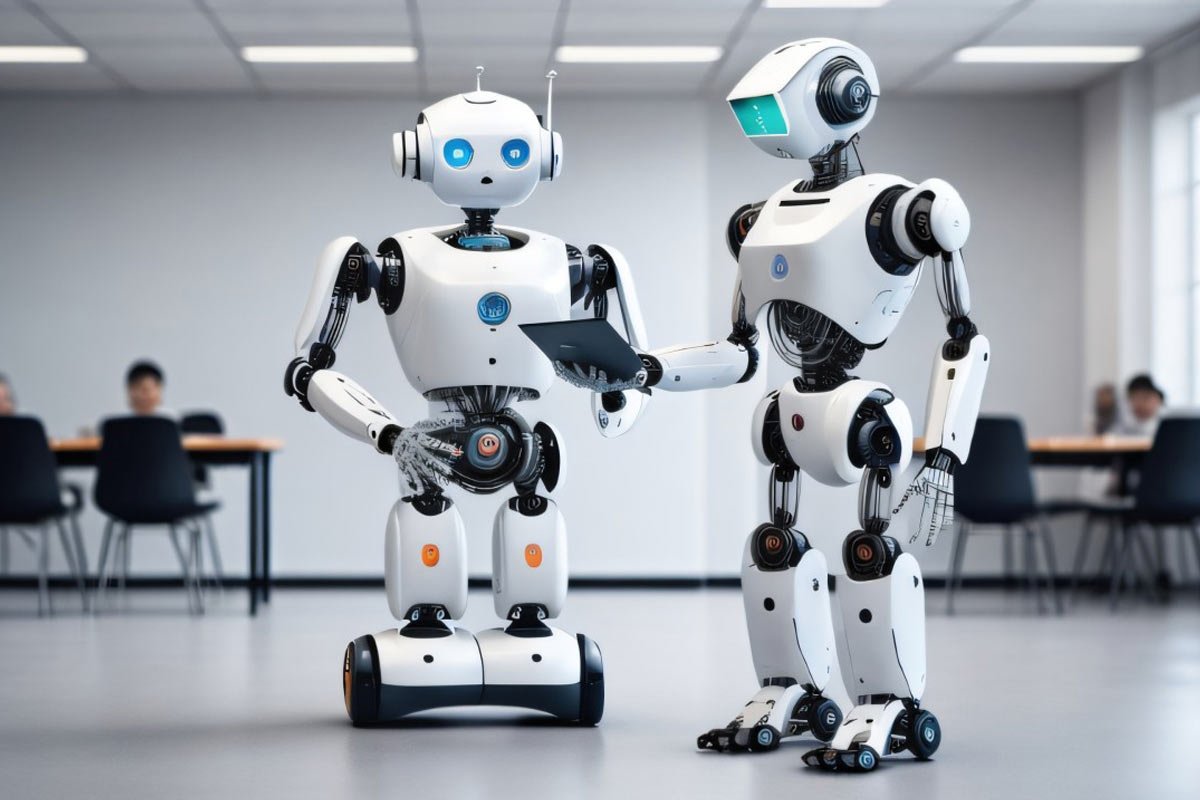Home Technology Best UI/UX Course in Kerala for a creative...
Read More- Home
- Technology
- Robots in Everyday Life
Robots in Everyday Life

Technology continues to develop rapidly in the fast-paced world and with that advancement robots are becoming more common in our daily lives. Robots are no longer a distant fantasy, they are improving how we live, work, and play. They are often used in factories and other industrial settings to perform dangerous and difficult tasks. The implementation of robots in different aspects of life, from vacuuming the floors to assisting in surgeries, robots has revolutionized. In industries, robots are taking over the difficult tasks that are dangerous to humans, which enhances our safety and efficiency. The robot’s interference in everyday life helps to focus us on more meaningful activities. As technology continuously evolves, it merges with our routines like self-driving cars and robotic assistants. The world of robotics is transforming the way we view the future and change the way we live for the better. Advanced technologies like AI, AR, VR, and robotics are gaining more attention among the public. Advanced AI and machine learning are crucial for robotics. It builds with versatility in mind that can perform complex tasks and adapt to changing environment in the future. Robots in everyday life brings it more easier and opens a vast opportunities to explore.
Examples of robots in everyday life

1. Collaborative Robots (Cobots)
Cobots are controlled by a human operator, which makes them safer for environments like factories where humans also work. The robots work with humans to complete the tasks; they are known as robotic staff augmentation. Collaboration with robots helps humans to tackle complex tasks and data without any risks. Collaborative robots are mainly used in industrial environments, factories, warehouses, shopping centers, and airports. It will enhance productivity and reduce accidents. There are many examples in our everyday life including autonomous self-driving cars, military drones, automatic vacuum cleaners, and machine-learning personal assistance like Siri and Cortana.
A notable example of a collaborative robot is Baxter, a small and lightweight Cobot with two arms. It is designed to work as a team with humans in places like factories. It is a user-friendly program to perform diverse tasks without any training.
2. Domestic Robots
Domestic robots are also known as personal service robots or companion robots, which are designed to assist with household chores. They are commonly used in homes and workplaces to perform tasks like cleaning, laundry, and caring the elders or disabled persons.
There are many examples of the domestic robot, one is the Roomba vacuum cleaner. It will clean the floors, carpets, and rugs. Another one is the Wakamaru robot, developed by Mitsubishi. It is designed for companionship for elderly individuals living alone or with challenges. This robot utilizes sensors and AI to monitor the user’s health, behaviour, and location. In case of emergencies, the robot will alert a caregiver or family member, and provide additional support and safety.
3. Medical Robots
Medical robots are used in hospitals, clinics, and even ambulances to perform various tasks in the healthcare sector. The main aim of medical robots is to simplify medical procedures and make them quicker and more accurate. These robots vary from basic tools that help the surgeons to advanced levels that can perform the entire surgeries on their own.
The most popular medical robot is the Da Vinci Surgical System developed by Intuitive Surgical. This robot performs minimally invasive surgeries through small cuts. The robot is equipped with surgical tools and another set of arms that manage cameras and lighting. The use of medical robots like the da Vinci system reduces the invasiveness of surgeries, which minimizes blood loss and lowers costs.
4. Entertainment Robots
Entertainment Robots are designed to engage people in various forms like animatronic toys, robotic clowns, and automated creatures. They provide relaxation, and fun, and entertain children. These robots can be remotely controlled through mobile or other electronic devices. Robots in everyday life provide various entertainment activities.
5. Educational Robots
Educational robots in everyday life are specially designed to enhance the learning experience. It is tailored for children with numerous safety features and is complementary to traditional teaching. Students will get hands-on opportunities to learn about machinery and delve into robotics within a controlled setting. Students might find it engaging to apply their knowledge by programming an animatronic figure.
Agricultural robots, Tele robots, and security robots are the other types of robots that are relevant robots in everyday life.
General benefits of robots

Robots in everyday life offer numerous benefits in one way or another. It not only helps humans in industries and companies, but it is also beneficial for domestic usage.
Safety
Robots can carry out tasks that are very difficult in hazardous environments. They also shield humans from dangerous situations.
Increase efficiency and productivity.
Robots can perform repetitive tasks faster and with greater precision than humans. It reduces the production time and minimizes the errors.
24/7 Operation
Robots do not require breaks like humans, they can operate around the clock which ensures uninterrupted workflows. They can repair problems without people having to step in and fix an issue in less time.
Less human errors
Robots ensure better accuracy in the workplace which reduces human errors. When humans work with humans, it will help them to minimize mistakes by carrying out critical tasks.
Enhanced security and surveillance
The robotic system is equipped with cameras and sensors which provide real-time surveillance and security monitoring. They can detect motion, and sound alarms, and even patrol large areas. Robots in everyday life enhances the security.

Conclusion
The interaction of robots in our everyday lives has a great impact on how we live, work, and interact with the world. Overall the invention of robots and technology is helping human beings to carry out tasks easily. It is more prevalent in our daily life and the common feature of all robots is the simplification of tasks for humans. Like any technological process, the use of robots also has both positive and negative aspects. For this, it is important to learn and get training from an ethical point of view. That is necessary for the positive coexistence of humans and robots. Robots and technology make daily tasks easier and improve health care, education, and agriculture to create a more sustainable world. Robots in everyday life is a future filled with endless opportunities and possibilities.
Sandhra Vijay
Content Writer
D Soft Technologies
Top 10 In-Demand Tech Skills for 2025 and Beyond
Home Technology Top 10 In-Demand Tech Skills for 2025 and...
Read MoreRecent Articles
Best UI/UX Course in Kerala for a Creative Career
Home Technology Best UI/UX Course in Kerala for a creative...
Read MoreTop 10 In-Demand Tech Skills for 2025 and Beyond
Home Technology Top 10 In-Demand Tech Skills for 2025 and...
Read More
